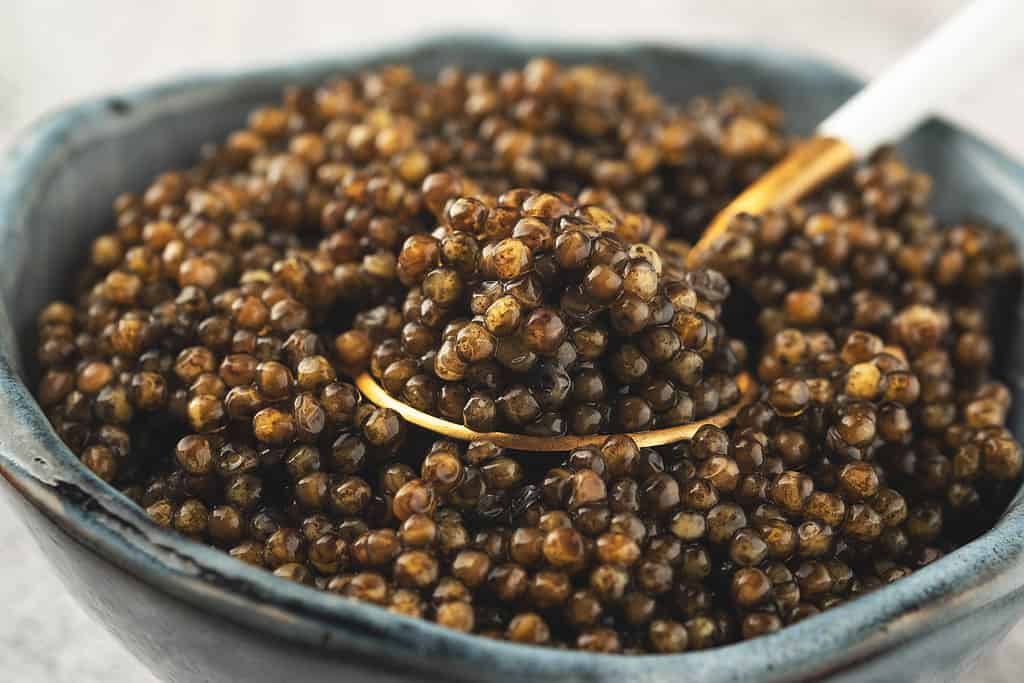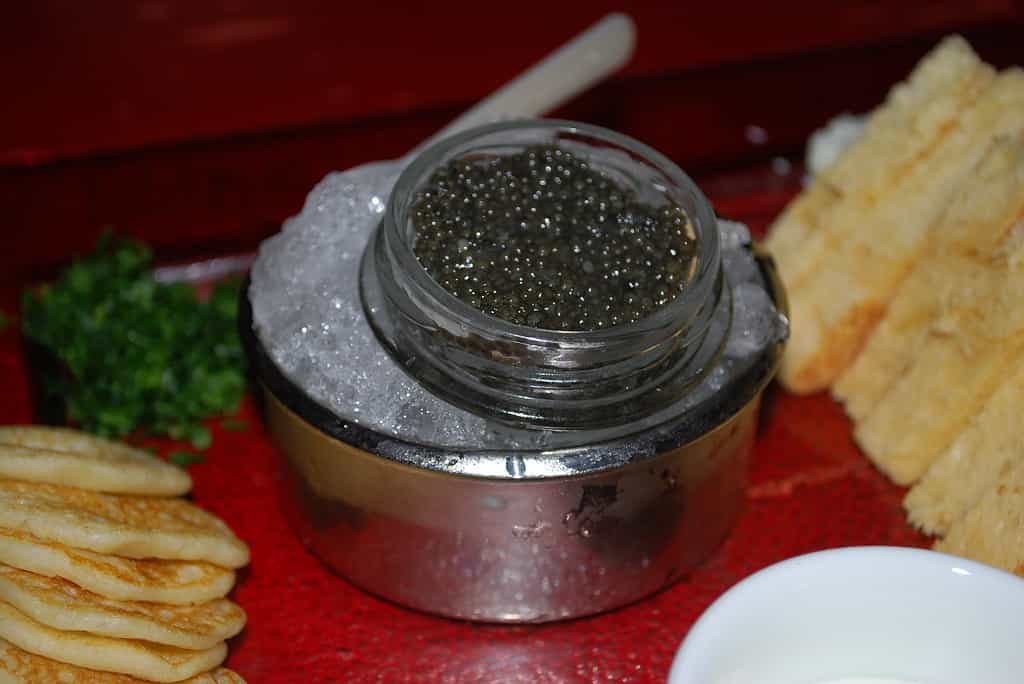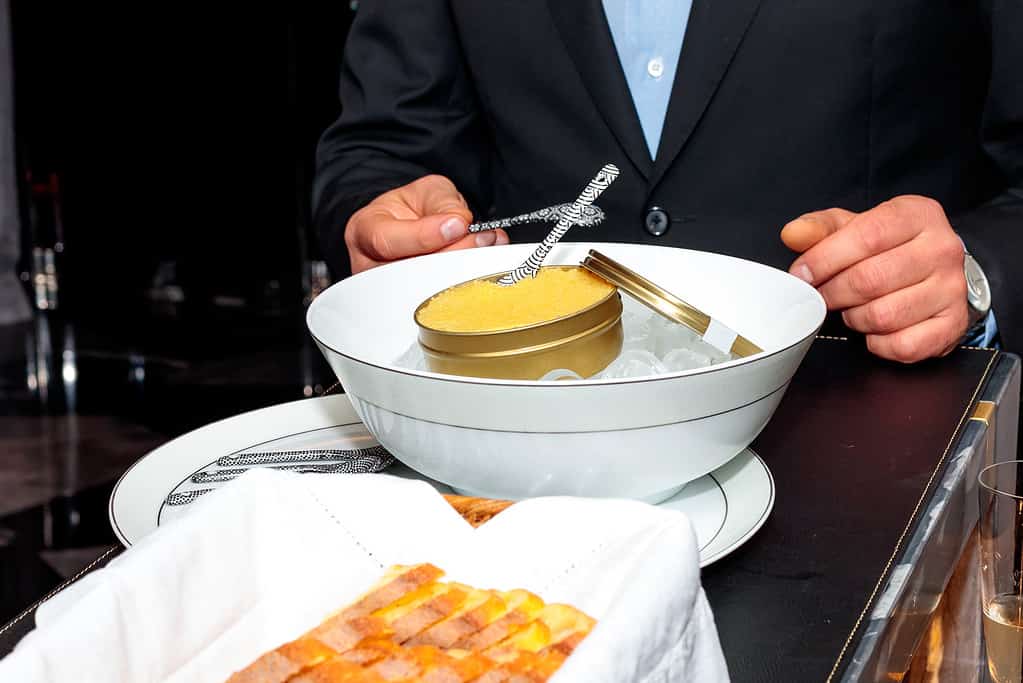Caviar. We’ve all heard of it, we’ve all been interested in what it tastes like, and we’ve all wondered why it’s so expensive. Maybe you went to a fancy party and had some caviar on a piece of bread or cracker. Or maybe you won a jar at a work party fundraiser. It’s in your fridge and you don’t know if you should save it for a special occasion or just put it out for the next birthday party. Then someone says that the jar is worth tens of thousands of dollars.
You wonder again, why caviar is so expensive. Well, let’s explore the top five reasons caviar is so expensive. We’ll go over each reason, one by one, in detail.
What Is Caviar?
First off, let’s start with what caviar is and then move on to the reasons why it’s so expensive. Caviar, in layman’s terms, are fish eggs. It’s roe that is cured in salt and that belongs to the Acipenseridae fish. Caviar is usually eaten as a spread or garnish. Usually, caviar comes from the roe of wild sturgeon found in the Caspian and Black Seas. Those caviars are called beluga, ossetra, and sevruga caviars.
Other roe can be called caviar from other fish, like salmon, trout, carp, whitefish, or steelhead. However, the international community has agreed that the term “caviar,” refers to the expensive delicacy.
1. Type of Fish

The beluga caviar comes from the beluga
sturgeon
in the Caspian Sea. Beluga caviar is usually black or gray and its flavor is rich.
©ALLEKO/iStock via Getty Images
The first reason on the list is the type of fish. Sturgeon caviar is the true caviar that the international community agrees is a delicacy. Although caviar has been around since the 10th century at the height of the Byzantine Empire, it was the Russians in the 19th century that converted it into a delicacy used for consumption by the wealthy. But in the 20th century, demand for caviar went through the roof, which is why it’s now extremely pricy. Fishermen were busy catching sturgeon or even harvesting sturgeon to make more money.
But now, two-thirds of species from the Acipenseridae family are on the endangered species list, which is why sturgeon caviar is extremely expensive in today’s times. Wild-caught sturgeon is much more expensive but because of governmental regulations, the price has shot up and is now unaffordable even in wealthy circles. Fortunately, many businesses have started to farm sturgeon, which brought prices down and has avoided the scarcity issue. Although, if you want caviar from wild-caught sturgeon, expect to pay a hefty price.
There are several species of sturgeon, but the most expensive one is the beluga caviar from the beluga sturgeon. The beluga sturgeon comes from the Caspian Sea.
2. Time of Production

The American caviar comes from the Atlantic sturgeon, white sturgeon, or lake sturgeon. It can have a grayish or dark color and has a salty flavor.
©christiannafzger/iStock via Getty Images
The time it takes to produce the caviar is long and that is another reason why it’s so expensive. Most fish can provide millions of eggs much more frequently than the sturgeon. But of course, to keep up with our demand, there needs to be sturgeon surviving into adulthood so they can lay eggs, as well. And so, it takes sturgeons much more time than other fish to do so.
The other factor that comes into play is the amount of time for the sturgeon to mature to create their eggs. This could take a few years or even a decade until a female sturgeon is ready. All of this means that the wait is a treacherous adventure that sturgeon farmers consider when selling the caviar.
3. Harvesting and Manufacturing

The ossetra caviar comes from the ossetra sturgeon. Ossetra caviar is brown or gold-colored and will have a salty or sea-like flavor.
©yulya_talerenok/Shutterstock.com
We move on to the manufacturing and harvesting process. Like all expensive things, they can also be quite difficult. The process is a tumultuous one. When the fish is sexually mature, they are taken to be analyzed and harvested. One important note is that the sturgeon has to be killed to remove the roe. There are no-kill methods, but the caviar isn’t as pure. The roe inside the sturgeon has to be removed by hand, so it will take a long time before all roe have been taken out. Then there’s the screening and washing step, which needs to be done with great care.
Afterward, farmers usually follow a straight process where they grade the roe aesthetically, they salt it, and then they grade it for texture and flavor. Next, they pack it, store and age it, repack it, pasteurize it, and finally ship it to their destinations to be sold. It is an arduous process that can take decades to complete.
4. Caviar’s Quality

The sevruga caviar comes from the sevruga,
Siberian
, or sterlet sturgeons. Sevruga caviar is a dark gray color and can have a buttery flavor.
©Michael P. D’Arco/Shutterstock.com
All farmers — whether they farm fruits, vegetables, fish, or chicken — have to inspect the quality of the product they are about to sell. If there’s something wrong with the quality, then the product is thrown away. The same goes for caviar. Every single roe is inspected and given a grade. The grading system will rate the size of each egg, the color, the flavor, and many other factors. The goal of the seller is to have Grade 1 (or A-Grade) caviar. If there’s something that doesn’t fulfill Grade 1 requirements but is to standard, it will be assigned Grade 2 (or B-Grade) and it will be sold at a more affordable price.
5. Supply and Demand
The first lesson in economics class was supply and demand. If you have less supply, demand usually increases. When it comes to caviar, the demand is always there and caviar is scarce, which means it’s extremely expensive. All of the reasons outlined above have created a food that is for the wealthy because of its exorbitant price tag.
World’s Most Expensive Type of Caviar

The Strottarga Bianco caviar, which comes from the Siberian albino sturgeon, is the most expensive caviar (and food) in the world.
©Wirestock Creators/Shutterstock.com
As we indicated, the beluga caviar is the most expensive of all types of caviar. But there are a few brands out there that are some of the most expensive types of caviar available to buy. The most expensive type of caviar in the world is Strottarga Bianco caviar, which comes from the Siberian albino sturgeon. It takes ten years to harvest and 22-karat gold flakes are added to the white-colored caviar. This caviar is also the most expensive food in the world and it comes to a whopping $113,630 per kilogram (or 2.2 pounds).
Conclusion
And there you have it, the top five reasons caviar is so expensive. Caviar, in essence, are fish eggs, or roe. Many of us have gone to a sushi restaurant and wondered what the tiny, squishy orange balls are. The answer is that’s caviar (or fish roe). Of course, the caviar that everyone refers to as the expensive delicacy is not salmon roe and you won’t find them at any sushi restaurant, either. The caviar from the wild sturgeon is rare, hence why it can cost tens of thousands of dollars for a small jar.
The next time you find yourself in the position where you have that tiny jar of expensive caviar, think to yourself what you want to do with it. Do you want to save it for a special occasion or do you want to spread that caviar on a cracker and eat it with a nice glass of wine on a random Saturday? The choice is yours, but know that the spoonful of ossetra caviar you just put in your mouth probably costs two grand.
The photo featured at the top of this post is © iStock.com/nndanko
Thank you for reading! Have some feedback for us? Contact the AZ Animals editorial team.







